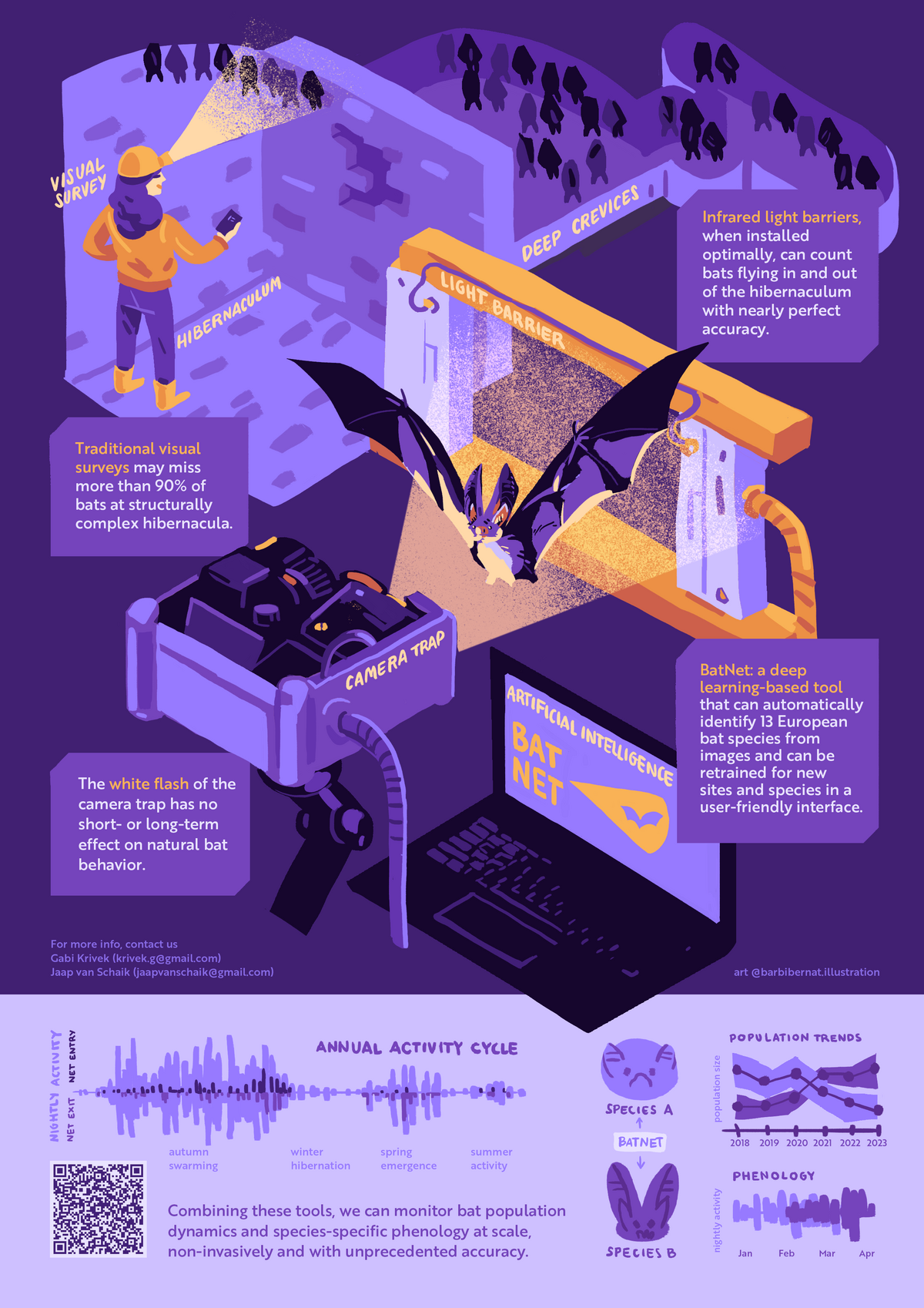
Dr. Gabriella Krivek
Applied Zoology and Nature Conservation
Soldmannstr. 14
17489 Greifswald
Tel.: +49 (0)3834 420-4358
gabriella.krivekuni-greifswaldde
Research Interests
Automated bat monitoring
My research focuses on developing and applying automated monitoring tools to study biodiversity at large temporal and spatial scales. By combining ecology with data science, I aim to understand how human-induced environmental change shapes wildlife populations, behavior, and phenology.
For European bats, I use infrared light barriers and camera traps installed at the entrances of hibernation sites to monitor population dynamics and seasonal activity patterns. These methods provide a unique, non-invasive way to record every movement in and out of a site with unprecedented resolution and accuracy. The challenge—and opportunity—lies in translating such “big data” into meaningful ecological insights.
During my PhD, I developed standardized analysis pipelines for light-barrier and camera trap data, and created a deep-learning solution (BatNet) for automated bat species identification from images. These tools enable fine-scale monitoring of bat population dynamics and can help uncover the environmental drivers of hibernation phenology in different bat species.
Currently, as a postdoctoral researcher in the BatTrend project, my main focus is integrating automated monitoring approaches to improve bat population trend assessments in Germany. In parallel, I work with a long-term RFID-logging dataset to study individual-level hibernation phenology and its sensitivity to environmental change.
Publications
Krivek, G., Meier, F., Grosche, L., Kerth, G. , & van Schaik, J. (2025). One Species Hibernates Shorter, the Other Longer: Rapid but Opposing Responses to Warming Climate in Two Sympatric Bat Species. Global Change Biology 31, no. 10: e70531. https://doi.org/10.1111/gcb.70531.
Meier, F., Grosche, L., Krivek, G., Runkel, V., Scheuerlein, A., Kerth, G., & Van Schaik, J. (2025). Automated long‐term monitoring of RFID‐tagged individuals reveals high hibernaculum site fidelity in Daubenton's bats and Natterer's bats. Animal Conservation, 28(3), 401-409. https://doi.org/10.1111/acv.12992
Krivek, G., Gillert, A., Harder, M., Fritze, M., Frankowski, K., Timm, L., Meyer-Olbersleben, L., Freiherr von Lukas, U., Kerth, G., van Schaik, J. (2023) BatNet: a deep learning-based tool for automated bat species identification from camera trap images. Remote Sensing in Ecology and Conservation. https://zslpublications.onlinelibrary.wiley.com/doi/full/10.1002/rse2.339
Video abstract about BatNet: https://www.youtube.com/watch?v=y7Zis3qVimI
Krivek, G., Mahecha, E.P.N., Meier, F., Kerth, G. & van Schaik, J. (2023), Counting in the dark: estimating population size and trends of bat assemblages at hibernacula using infrared light barriers. Animal Conservation. https://doi.org/10.1111/acv.12856
Krivek, G., Schulze, B., Poloskei, P. Z., Frankowski, K., Mathgen, X., Douwes, A., & van Schaik, J. (2022). Camera traps with white flash are a minimally invasive method for long‐term bat monitoring. Remote Sensing in Ecology and Conservation. https://doi.org/10.1002/rse2.243
Krivek, G., F. V. Florens, C. Baider, V. O. Seegobin, T. Haugaasen (2020). Invasive alien plant control improves foraging habitat quality of a threatened island flying fox, Journal for Nature Conservation 54, 125805. https://doi.org/10.1016/j.jnc.2020.125805
F.B.V. Florens, C. Baider, V. Marday, G.M.N. Martin, Z. Zmanay, R. Oleksy, G. Krivek, C.E. Vincenot, D. Strasberg, T. Kingston (2017). Disproportionately large ecological role of a recently mass-culled flying fox in native forests of an oceanic island. Journal for Nature Conservation 40, 85-93. https://doi.org/10.1016/j.jnc.2017.10.002

